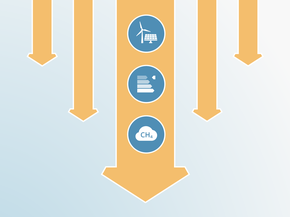Targets
Target overview
Egypt submitted its Second Updated 2030 NDC to the UNFCCC on 26 June 2023, strengthening only its emissions reduction target in the power sector.
Egypt’s NDC still does not include an economy-wide emissions reduction target but rather presents emissions reductions to be achieved in the electricity, transport and oil & gas sub-sectors. Egypt also lists measures for the industry, buildings, tourism and waste sectors but does not commit to specific emissions reductions in those sectors. The agriculture and land use sectors are excluded from mitigation action in the NDC. The lack of transparency in the NDC makes any assessment of the targets difficult.
The NDC is conditional on Egypt receiving international support. Egypt does not specify whether any portion of the NDC is unconditional.
We estimate Egypt can easily overachieve its NDC target with the policies it has already put in place, and it should therefore submit a strengthened target that incentivises additional emission reductions.
Egypt does not have a net zero emissions target, nor has it submitted a Long-Term Strategy to the UNFCCC as of September 2025.
| EGYPT — Main climate targets |
|---|
| 2030 unconditional NDC target | |||
|---|---|---|---|
| Formulation of target in NDC | Egypt does not have an unconditional NDC target | ||
|
Absolute emissions level in 2030 excl. LULUCF |
N/A | ||
| Status | N/A | ||
| 2030 conditional NDC target | |||
|---|---|---|---|
| Formulation of target in NDC |
Sectoral emissions reduction targets compared to a business as usual (BAU) scenario in 2030: • Electricity (37% below BAU)* • Transport (7% below BAU)* • Oil & gas (65% below BAU)* |
||
|
Absolute emissions level in 2030 excl. LULUCF |
539–554 MtCO2e [76–80% above 2010] |
||
| Status | Submitted on 26 June 2023 | ||
| Net zero & other long-term targets | |||
|---|---|---|---|
| Formulation of target | Egypt does not have a net zero target, nor has it submitted a long-term strategy (LTS) to the UNFCCC as of September 2025. Egypt’s 2050 National Climate Change Strategy does not have an emissions reduction target. | ||
|
Absolute emissions level in 2050 excl. LULUCF |
N/A | ||
| Status | N/A | ||
* See Assumptions section for a discussion on GWP values.
NDC updates
Egypt submitted its Second Updated NDC on 26 June 2023. This update is almost identical to its previous submission in 2022, with the exception of a slightly revised emissions reduction target in the power sector.
Egypt has committed to achieving 42% of renewable energy in its generation mix by 2030, five years earlier than under the previous NDC. Consequently, Egypt strengthened its emissions reduction target in the power sector by 10 MtCO2e or 14% compared to the previous target. However, since this revised target is the only modification, the overall impact of this NDC update remains minor.
The latest NDC still lacks transparency, making any quantitative assessment difficult. The target is conditional on international support and Egypt still does not have an unconditional emissions reduction target. The CAT estimates Egypt can easily overachieve this target with the policies it already has in place, even without international support.
This NDC still does not include an economy-wide emissions target but instead includes emissions reductions to be achieved in the following sub-sectors: electricity, transport and oil & fossil gas.
By 2030, Egypt pledges to the following emissions levels in these sectors:
- Electricity: 134 MtCO2e (down from a business-as-usual scenario of 215 MtCO2e, equivalent to 37% below BAU)
- Transport: 115 MtCO2e (down from a business-as-usual scenario of 124 MtCO2e, equivalent to 7% below BAU)
- Oil & fossil gas production (associated gases sub-sector): 0.9 MtCO2e (down from a business-as-usual scenario of 2.6 MtCO2e, equivalent to 65% below BAU)
*NOTE: The figures used in Egypt’s NDC use global warming potential values from the IPCC’s Second Assessment Report (SAR). For the calculation, we converted the SAR values to AR5 values (see the Assumptions section for further details).
These three sectors accounted for 43% of Egypt’s total GHG emissions in 2015, the baseline year. In total, Egypt pledges to reduce emissions by 92 MtCO2e below a business-as-usual pathway in these sectors.
The revised target for the electricity sector is more ambitious than the previous one, as Egypt aims to reach it five years earlier and clarifies that it pertains to the share of electricity generation rather than capacity.
Egypt also lists measures for the industry, buildings, tourism and waste sectors but does not commit to specific emission reductions. The NDC excludes the agriculture and land use sectors from mitigation action.
We estimate the conditional NDC target would lead to emissions increasing from around 397 MtCO2 in 2023 to 539–554 MtCO2e in 2030, or 76–80% above 2010. The emissions level resulting from this target is well above what we project Egypt’s emissions trajectory to be with the policies it has implemented.
Egypt has not communicated its economy-wide BAU scenario, making it difficult to quantify the overall emissions level resulting from the NDC. The NDC provides 2030 BAU values for the electricity, transport, and oil and fossil gas sub-sectors only. We have estimated 2030 BAU values by extrapolating the average annual growth trend observed over 2005–2015 to the 2015 baseline year reported in Egypt’s First Biennial Update Report (BUR1). This represents a methodological change from relying on external reference scenarios, as it ensures consistency with Egypt’s own reported data and provides a more transparent, data-driven basis for extrapolation. For more details on our calculations, please refer to the assumptions section.
| EGYPT — History of NDC updates | First NDC (2017) | 2022 NDC update | 2023 NDC update |
|---|---|---|---|
| 1.5°C compatible |
|
|
|
| Stronger target | N/A |
|
|
| Fixed/absolute target |
|
|
|
| EGYPT | First NDC (2017) | 2022 NDC update | 2023 NDC update |
|---|---|---|---|
| Formulation of target in NDC |
Conditional target: No emission reduction target |
Conditional target: Sectoral emissions reduction targets compared to a BAU projection for the electricity, oil & gas and transport sectors. The NDC also lists measures for the industry, buildings, tourism and waste sectors but without quantitative emissions reduction estimates. |
Conditional target: Sectoral emission reduction targets compared to a BAU projection for the electricity, oil & gas and transport sectors. The NDC also lists measures for the industry, buildings, tourism and waste sectors but without quantitative emission reduction estimates. |
|
Absolute emissions level excl. LULUCF |
Conditional target: — |
Unconditional target: No unconditional target (rating based on CAT estimate of an economy wide BAU scenario of 646 MtCO2e by 2030) Conditional target: 549–564 MtCO2e by 2030 |
Unconditional target: No unconditional target (rating based on CAT estimate of an economy wide BAU scenario of 646 MtCO2e by 2030) Conditional target: 539–554 MtCO2e by 2030 |
|
Emissions compared to 2010 excl. LULUCF |
Conditional target: — |
Unconditional target: N/A Conditional target: 79–84% above 2010 emissions by 2030 |
Unconditional target: N/A Conditional target: 76–80% above 2010 emissions by 2030 |
| CAT rating |
BAU scenario against fair share*: Highly insufficient Conditional NDC target against modelled domestic pathways* : Highly insufficient *CAT ratings were based on Egypt’s projected emissions level in 2030 under current policies, but downgraded by one level to reflect the fact that Egypt’s first NDC did not contain quantifiable targets. |
BAU scenario against fair share: Highly insufficient Conditional NDC target against modelled domestic pathways : Critically insufficient |
BAU scenario against fair share: Highly insufficient Conditional NDC target against modelled domestic pathways : Critically insufficient |
| Sector coverage |
Energy, industry, waste, agriculture* *We assume the above coverage as the NDC only listed mitigation measures in these four sectors |
Energy, industry, transport | Energy, industry, waste |
| Separate target for LULUCF | No | No | No |
| Gas coverage | — | CO2, CH4, N2O | CO2, CH4, N2O |
| Target type | — | Sectoral emissions reduction below BAU for some sectors and policies and measures for others | Sectoral emissions reduction below BAU for some sectors and policies and measures for others |
Target development timeline & previous CAT analysis
- 28.03.2022 First NDC
- 08.08.2022 First NDC update
CAT rating of targets
Developing countries like Egypt will need support to achieve emissions reductions in line with a physically required pathway to achieving the 1.5°C long-term temperature goal.
Egypt only has a conditional target. It has not specified whether a portion of the target is conditional on international support or whether its NDC has an international element. In the absence of an unconditional target, we use our estimate for Egypt’s business-as-usual target as its unconditional target and rate it against modelled domestic pathways.
The CAT rates Egypt’s conditional target “Critically Insufficient”. This rating indicates that Egypt’s conditional NDC target in 2030 reflects minimal to no action and is not at all consistent with the 1.5°C temperature limit. If all countries were to follow Egypt’s approach, warming would exceed 4°C.
The rating of Egypt’s conditional NDC target has deteriorated compared to our previous assessment due to an update in our modelled domestic pathways to the pathways assessed in the IPCC AR6. Our newer pathways better capture national circumstances and, for higher temperature levels, show less room for emissions growth than the previous set.
In the absence of an unconditional NDC emissions reduction target, the CAT takes Egypt’s estimated ‘business as usual’ scenario as its unconditional commitment and rates it “Highly insufficient”. This rating indicates that Egypt’s BAU scenario in 2030 leads to rising, rather than falling, emissions and is not at all consistent with its fair share of the global mitigation effort to limit warming to 1.5°C. If all countries were to follow Egypt’s approach, warming could reach over 3°C and up to 4°C.
Egypt would need to roughly stabilise emissions at today’s levels to meet its fair share of the global mitigation effort to keep temperature rise below 1.5°C.
The rating of the BAU against fair share has improved from “Critically Insufficient” to “Highly Insufficient”. This reflects a literature update to our fair share (FS) ranges, aligning our equity approaches with international environmental law and excluding studies based solely on cost-effectiveness. We also incorporated additional recent studies to capture the latest research in the field. Importantly, this adjustment does not indicate any actual improvement in Egypt’s climate targets compared to our previous assessment.
Further information on how the CAT rates countries (against modelled pathways and fair share) can be found here.
Net zero and other long-term target(s)
Egypt does not have a net zero target, nor has it submitted a long-term strategy (LTS) to the UNFCCC as of September 2025. Egypt launched its 2050 National Climate Change Strategy in May 2022 but it does not include an emissions reduction target.
Further analysis
Latest publications
Stay informed
Subscribe to our newsletter




